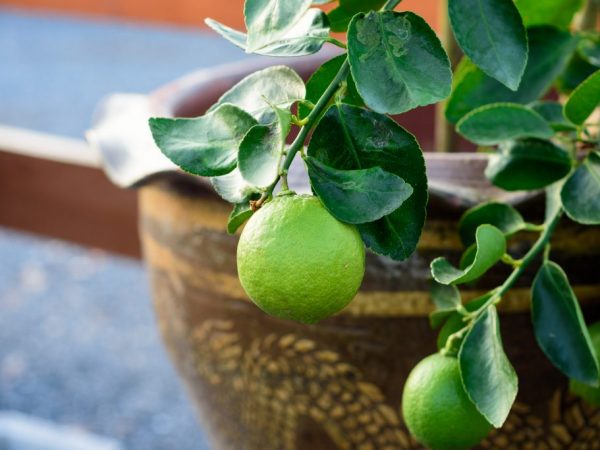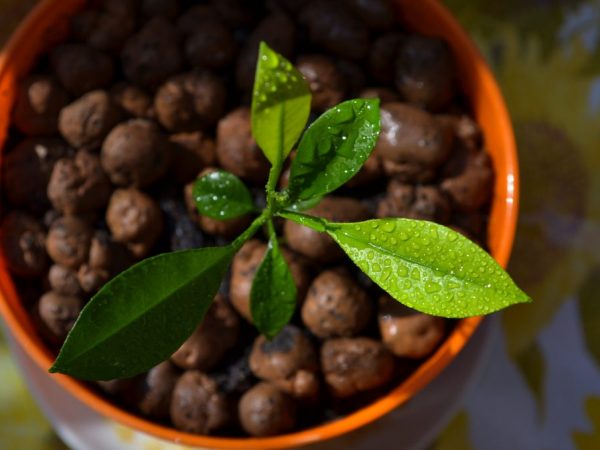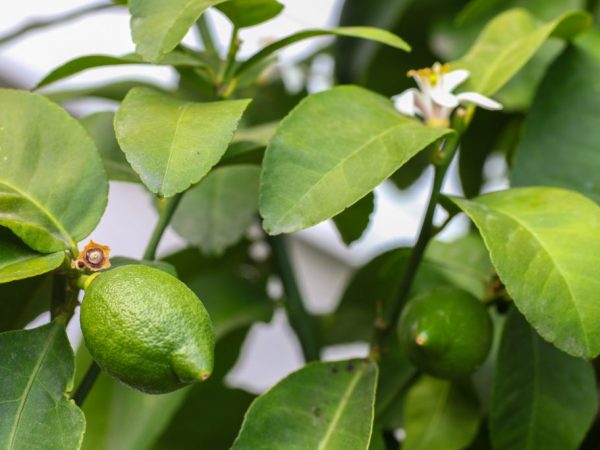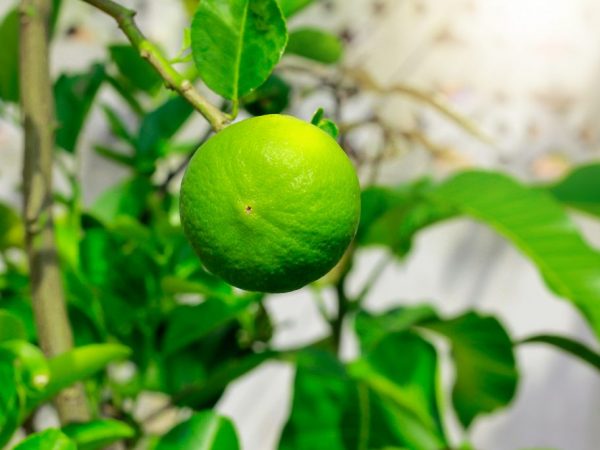Growing lime at home
Among all plants of the genus Citrus, indoor lime has become very popular. Anyone can grow a lime at home with proper care.

Growing lime at home
Plant characteristic
The birthplace of the plant is Southeast Asia (Malacca Peninsula). In its natural environment, this is a tall tree, reaching 1.5-4 m in height. The shoots contain small thorns. The leaves are long - up to 6 cm, up to 4 cm wide, dark green or emerald green.
The flower is white, formed in the axils of the leaves. The fruit is small in size - 5-6 cm in diameter. The fruit tastes sour or sweet, depending on the variety. The pulp is green, juicy.
Description of the plant:
- height no more than 2 m;
- the crown is spreading, contains many shoots, densely leafy;
- branches are covered with thorns 1-2 cm long;
- green fruits with tasty and juicy pulp.
The fruits of the plant are widely used in cooking for the preparation of various dishes - salads, desserts, drinks. This fruit tastes much sour than tangerine and lemon. Low calorie content (16 kcal per 100 g of product) allows you to include this fruit in the diet for those who want to lose weight. Of all the varieties, the Tahitian lime is the most popular. This lime variety is used in the preparation of the well-known mojito drink.
Growing features
You can grow a lime tree at home in two ways:
- seeds;
- cuttings.
Cuttings
To plant a lime tree, you need to cut off a 10-15 cm long shoot from the top of the tree. Such a shoot should have at least 5 healthy vegetative buds. All leaves on the handle are removed, leaving only 3 of the strongest and largest.
The cut is made at an angle of 45 ° using a sharp sterile instrument - a knife or secateurs. The cut cutting is treated with a root formation stimulant - Kornevin or Heteroauxin. Then the shoot is planted in wet sand.
For germination of indoor lime, special conditions are required - high humidity and temperature. Therefore, the plant is placed in a well-lit place where there is no direct sunlight and covered with a half of a plastic bottle. The escape should be regularly ventilated and sprayed.
If everything is done correctly, in a month the indoor tree will take root. After that, he is gradually accustomed to room conditions, removing the shelter daily. Plants are transplanted into separate pots with a diameter of about 6-7 cm. Limes are planted in pots made of ceramic or clay material. In such a container, the root system of the plant is less susceptible to decay and will fully develop. The resulting hybrid begins to bloom and bear fruit as early as 3 years after planting.
Seed cultivation

Provide the plant with optimal conditions
When growing a lime at home, you need a seed from a quality fruit.Choose ripe fruit without mechanical damage and rot. The seeds are washed, then dried for 2 hours. For planting lime seeds, you must use a special substrate made of universal soil and coarse sand in a 1: 1 ratio. A layer of expanded clay (1.5 cm) is placed on the bottom of the pot, then the nutrient mixture is poured.
Seeds should be germinated in greenhouse conditions. In the process of germination, they are periodically ventilated and irrigated with warm water from a spray bottle. The success of growing a lime tree in this way will depend on a stable temperature regime in the greenhouse - 25-26 °.
Germination will take 2 to 4 months. Several sprouts are obtained from one seed.
They choose strong sprouts, on which 2-3 leaves have formed. The plantings are gradually accustomed to room air, then the seedlings are picked into separate containers with a diameter of no more than 6 cm. The composition of the soil is the same as when planting cuttings.
The first fruiting from seeds will begin at 4-5 years of age. The advantage of such cultivation is that the new plant retains all the varietal characteristics of the parent specimen.
Care rules
Maintaining a lime at home is not much different from growing a pomelo, orange, or other citrus plants.
Illumination
It is a sun-loving plant that prefers bright, diffused light. The best location is a window sill on the east or west side. The southern windowsill will require shading from the sun, especially at noon. Provide artificial supplementary lighting in the northern side.
A lime tree needs 12 hours of daylight.
Temperature
Depending on the season, homemade lime needs a different temperature of content. During the spring-summer period, this indicator is 30-35 °, in the autumn-winter period - 20-25 °. With this temperature regime, the plant will fully develop, bloom profusely and bear fruit.
Humidity

High humidity is important for wood
This plant needs high humidity throughout the year:
- daily irrigation of the crown from a spray bottle;
- shower with warm water - at least 2 times a month;
- placing the plant on a pallet with moistened sphagnum moss or expanded clay;
- placement of containers with water in the room.
Watering
Moderate watering is required when the topsoil dries out. In winter, watering is reduced - up to 3 times a month. Use room temperature water.
Fertilizer
Growing lime in a pot requires regular fertilizing. A balanced diet will provide the plant with health and high-quality fruiting.
Twice a week, the plant is fed with a special complex fertilizer for citrus fruits. You can also use mineral and organic feed alternately. Mullein solution is used as organic matter. In winter, if the plant is kept in conditions of low temperature, no top dressing is applied. When kept warm in autumn and winter, lime is fed twice a week. The soil is spilled with a liquid solution until it begins to flow through the drainage holes. Top dressing is applied the next day after watering, which eliminates the risk of burning the root system.
Phosphorus-potassium preparations are used as mineral fertilizers. They stimulate the growth and development of the tree, as well as its flowering and fruiting.
Some growers use an unusual top dressing for this plant - fish ear. 200 g of fresh fish waste is poured with water, boiled for 5-7 minutes. Then it is diluted with boiled water in a ratio of 1: 2. Cool and filter through cheesecloth. Apply liquid fertilizer once a month after the plant reaches 1 m in height.
Pruning
Growing involves an annual haircut. Crown formation begins immediately after planting. Its apical shoot is cut off to stimulate the development of lateral branches.
The next year, all shoots are trimmed by 1/3 of the length. Shearing of all damaged, broken off branches is carried out.
Features of the formation of the crown in subsequent years consist in carrying out a sanitary haircut, removing branches that thicken the crown and growing at the wrong angle.
Transfer
They survive the plant in a new pot annually in late winter - early spring. Mature trees are transplanted less often - if the roots begin to grow through the drainage holes. For them, the surface layer of the earth is being replaced.
A commercial citrus mixture is suitable for transplanting, which has good moisture and air permeability. You can also plant in a mixture of turf, leaf, humus earth and sand, mixed in equal amounts. To eliminate the risk of injury to the roots, the transplant is carried out by transferring the earthen lump into a container 2-3 cm larger.
Diseases and pests

Examine the plant for signs of disease
Most often this tree is affected by a spider mite, a scabbard and a mealybug.
Signs:
- the leaves are deformed, turn yellow and fall off;
- gray or black bloom appears on the upper side of the leaf plate;
- sticky coating on foliage and shoots;
- the appearance of microscopic bugs of red or red color;
- lumps in the form of a foam on the underside of the leaves or in the area of internodes;
- the appearance of a cobweb on the leaves;
- lime stops growing, does not bloom and sheds leaves en masse.
To destroy pests, the crown of plants is sprayed with soapy water. If such processing is unsuccessful, chemical preparations are used - Actellik or Aktara.
Of the diseases, lime is most often annoyed by homoz. Small cracks on the shoots, from which a sticky liquid flows, are the main symptom of this disease. Such a plant dries up quickly and dies. The reasons for the development are too deep planting, frequent overflows and watering with cold water. The affected parts of the plant are treated with a solution of copper sulfate 3%. Then the barrel is lubricated with copper sulfate paste or lime paste.
Indoor varieties
Among all varieties, the following varieties of lime are most popular with flower growers:
- Palestinian;
- Mexican;
- lime tahiti;
- kaffir or kaffir;
- calamansi (musky)
- rangipur;
- limequat (limonella);
- lime kumquat;
- citrofortunella;
- orange (limetta).
Conclusion
It is not difficult to care for this plant. If you follow all the above rules of maintenance, you will be able to grow a beautiful, flowering lime tree.


